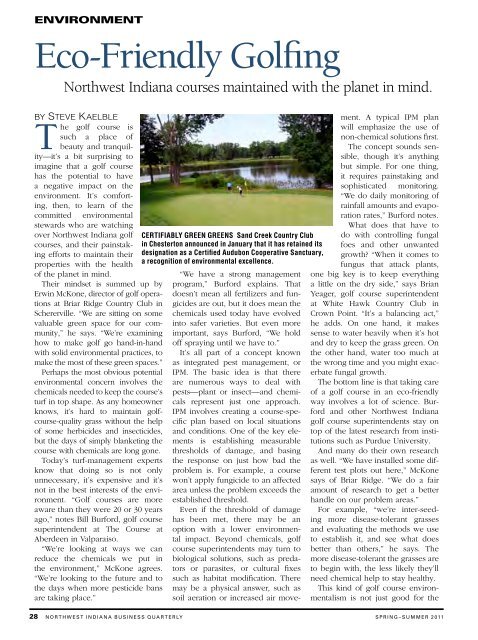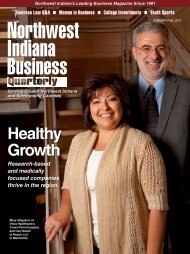Spring 2011 - Northwest Indiana Business Quarterly Magazine
Spring 2011 - Northwest Indiana Business Quarterly Magazine
Spring 2011 - Northwest Indiana Business Quarterly Magazine
You also want an ePaper? Increase the reach of your titles
YUMPU automatically turns print PDFs into web optimized ePapers that Google loves.
eNVirONMeNT<br />
Eco-Friendly Golfing<br />
<strong>Northwest</strong> <strong>Indiana</strong> courses maintained with the planet in mind.<br />
by Steve Kaelble<br />
The golf course is<br />
such a place of<br />
beauty and tranquility—it’s<br />
a bit surprising to<br />
imagine that a golf course<br />
has the potential to have<br />
a negative impact on the<br />
environment. It’s comforting,<br />
then, to learn of the<br />
committed environmental<br />
stewards who are watching<br />
over <strong>Northwest</strong> <strong>Indiana</strong> golf<br />
courses, and their painstaking<br />
efforts to maintain their<br />
properties with the health<br />
of the planet in mind.<br />
Their mindset is summed up by<br />
Erwin McKone, director of golf operations<br />
at Briar Ridge Country Club in<br />
Schererville. “We are sitting on some<br />
valuable green space for our community,”<br />
he says. “We’re examining<br />
how to make golf go hand-in-hand<br />
with solid environmental practices, to<br />
make the most of these green spaces.”<br />
Perhaps the most obvious potential<br />
environmental concern involves the<br />
chemicals needed to keep the course’s<br />
turf in top shape. As any homeowner<br />
knows, it’s hard to maintain golfcourse-quality<br />
grass without the help<br />
of some herbicides and insecticides,<br />
but the days of simply blanketing the<br />
course with chemicals are long gone.<br />
Today’s turf-management experts<br />
know that doing so is not only<br />
unnecessary, it’s expensive and it’s<br />
not in the best interests of the environment.<br />
“Golf courses are more<br />
aware than they were 20 or 30 years<br />
ago,” notes Bill Burford, golf course<br />
superintendent at The Course at<br />
Aberdeen in Valparaiso.<br />
“We’re looking at ways we can<br />
reduce the chemicals we put in<br />
the environment,” McKone agrees.<br />
“We’re looking to the future and to<br />
the days when more pesticide bans<br />
are taking place.”<br />
CERTIFIABLY GREEN GREENS Sand Creek Country Club<br />
in Chesterton announced in January that it has retained its<br />
designation as a Certified Audubon Cooperative Sanctuary,<br />
a recognition of environmental excellence.<br />
“We have a strong management<br />
program,” Burford explains. That<br />
doesn’t mean all fertilizers and fungicides<br />
are out, but it does mean the<br />
chemicals used today have evolved<br />
into safer varieties. But even more<br />
important, says Burford, “We hold<br />
off spraying until we have to.”<br />
It’s all part of a concept known<br />
as integrated pest management, or<br />
IPM. The basic idea is that there<br />
are numerous ways to deal with<br />
pests—plant or insect—and chemicals<br />
represent just one approach.<br />
IPM involves creating a course-specific<br />
plan based on local situations<br />
and conditions. One of the key elements<br />
is establishing measurable<br />
thresholds of damage, and basing<br />
the response on just how bad the<br />
problem is. For example, a course<br />
won’t apply fungicide to an affected<br />
area unless the problem exceeds the<br />
established threshold.<br />
Even if the threshold of damage<br />
has been met, there may be an<br />
option with a lower environmental<br />
impact. Beyond chemicals, golf<br />
course superintendents may turn to<br />
biological solutions, such as predators<br />
or parasites, or cultural fixes<br />
such as habitat modification. There<br />
may be a physical answer, such as<br />
soil aeration or increased air move-<br />
ment. A typical IPM plan<br />
will emphasize the use of<br />
non-chemical solutions first.<br />
The concept sounds sensible,<br />
though it’s anything<br />
but simple. For one thing,<br />
it requires painstaking and<br />
sophisticated monitoring.<br />
“We do daily monitoring of<br />
rainfall amounts and evaporation<br />
rates,” Burford notes.<br />
What does that have to<br />
do with controlling fungal<br />
foes and other unwanted<br />
growth? “When it comes to<br />
fungus that attack plants,<br />
one big key is to keep everything<br />
a little on the dry side,” says Brian<br />
Yeager, golf course superintendent<br />
at White Hawk Country Club in<br />
Crown Point. “It’s a balancing act,”<br />
he adds. On one hand, it makes<br />
sense to water heavily when it’s hot<br />
and dry to keep the grass green. On<br />
the other hand, water too much at<br />
the wrong time and you might exacerbate<br />
fungal growth.<br />
The bottom line is that taking care<br />
of a golf course in an eco-friendly<br />
way involves a lot of science. Burford<br />
and other <strong>Northwest</strong> <strong>Indiana</strong><br />
golf course superintendents stay on<br />
top of the latest research from institutions<br />
such as Purdue University.<br />
And many do their own research<br />
as well. “We have installed some different<br />
test plots out here,” McKone<br />
says of Briar Ridge. “We do a fair<br />
amount of research to get a better<br />
handle on our problem areas.”<br />
For example, “we’re inter-seeding<br />
more disease-tolerant grasses<br />
and evaluating the methods we use<br />
to establish it, and see what does<br />
better than others,” he says. The<br />
more disease-tolerant the grasses are<br />
to begin with, the less likely they’ll<br />
need chemical help to stay healthy.<br />
This kind of golf course environmentalism<br />
is not just good for the<br />
28 NORTHWEST INDIANA BUSINESS QUARTERLY SpRINg–SUmmER <strong>2011</strong>









